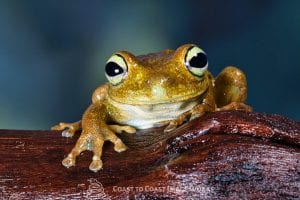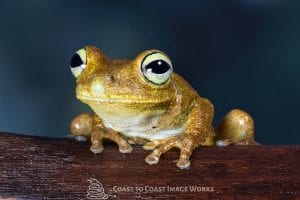 A commonly found treefrog in its natural distribution area, a huge area including Brazil, Colombia, French Guiana, Guyana, Panama, Suriname, Trinidad, Tobago, and Venezuela. As well as having a huge range it lives in a wide variety of habitat and can almost be found anywhere from sea level through to nearly 2500m altitude. A very successful species, and tolerant of many conditions.
A commonly found treefrog in its natural distribution area, a huge area including Brazil, Colombia, French Guiana, Guyana, Panama, Suriname, Trinidad, Tobago, and Venezuela. As well as having a huge range it lives in a wide variety of habitat and can almost be found anywhere from sea level through to nearly 2500m altitude. A very successful species, and tolerant of many conditions.
Its variable in appearance, and can also change shades too – I have seen specimens that are golden brown through to a muddy green colouration. Their eye is quite stunning, as the name suggests, and has a distinct set of two colours, around the pupil is a sparkling white grey colour, this is lined with a yellow to emerald green border. They are sexually dimorphic, as in the females are always around a cm longer than the males, at around 7cm.
They are easy to cater for in captivity, provide a tall glass terrarium heated to around 20-25C. Light can be provided for, some keepers say  its essential. We would suggest an Arcadia ShadeDweller T5 light for this purpose. They are ideally suited to a naturally planted terrarium, and will display very well in such a vivarium. They can be planted with an array of plants such as ficus, bromeliads and other semi-tropical and tropical plants. Planted around a well designed terrarium with logs, and branches the results will provide a fantastically natural home for this species.
its essential. We would suggest an Arcadia ShadeDweller T5 light for this purpose. They are ideally suited to a naturally planted terrarium, and will display very well in such a vivarium. They can be planted with an array of plants such as ficus, bromeliads and other semi-tropical and tropical plants. Planted around a well designed terrarium with logs, and branches the results will provide a fantastically natural home for this species.
Food is provided with a large mix of insects, commercially available species include locusts (smaller sizes), crickets (both Quiet and Black),  Curly Wing flies, Waxworms and most ofther livefood insects sold in pet shops. Ensure all livefood is gutloaded with a quality insect food, this benefits the frogs, and of course powder all insects with a good quality mulit-vitamin / mineral powder.
Curly Wing flies, Waxworms and most ofther livefood insects sold in pet shops. Ensure all livefood is gutloaded with a quality insect food, this benefits the frogs, and of course powder all insects with a good quality mulit-vitamin / mineral powder.
Keep handling to a minimum, and always use rainwater ot dechlorintated water. Other than that, they are an easy species to cater for.
